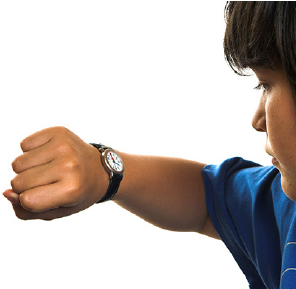This problem solving activity has a number focus.

These students are to sit an exam that begins at 9:30 pm sharp.
Which of them will get there in time for the start of the exam?
Derek’s watch is 15 minutes fast but he thinks that it is 10 minutes fast.
Marilyn’s watch is 15 minutes fast but she thinks it is 20 minutes fast.
Sara’s watch is 15 minutes slow but she thinks it is 10 minutes fast.
Tim’s watch is 15 minutes slow but he thinks that it is 10 minutes slow.
- Understand how positive and negative numbers can be used in an unusual practical problem.
- Devise and use problem solving strategies to explore situations mathematically (guess and check, be systematic, look for patterns, draw a diagram, make a table, use algebra).
This logic problem, involving positive and negative numbers in a practical situation, may challenge students and generate interesting discussion. Students need to possess knowledge of time to work successfully with this problem.
- Copymaster of the problem (English)
- Copymaster of the problem (Māori)
- A clock (a digital version could be used)
The Problem
These students are to sit an exam that begins at 9:30 pm sharp. Which of them will get there in time for the start of the exam?
Derek’s watch is 15 minutes fast but he thinks that it is 10 minutes fast.
Marilyn’s watch is 15 minutes fast but she thinks it is 20 minutes fast.
Sara’s watch is 15 minutes slow but she thinks it is 10 minutes fast.
Tim’s watch is 15 minutes slow but he thinks that it is 10 minutes slow.
Teaching Sequence
- Pose the problem for students to work on in their groups. Allow discussion.
- When groups believe they know about at least one of the examinees, pause for discussion.
- Take a vote on which of the four people get to the exam late and have students give reasons for their choices.
- Reach a consensus.
- Give time for the students finish the problem and begin on the extension as appropriate.
- Have students share their results with reference to their written solutions. Encourage them to use the clock to model their solutions.
Extension
There are other possibilities for people’s watches. They could be fast but they think they’re slow; they could be slow but they think they’re fast; they could be slow and their owners think that they are slower than that, and so on. Investigate the other possibilities.
Solution
There are many ways of solving this problem. Here is one approach, using a table for each examinee.
Derek.
actual time | watch time | time Derek thinks it is |
9:30 | 9:45 | 9:35 |
9:25 | 9:40 | 9:30 |
If it was 9:30, Derek’s watch would show 9:45 because it is 15 minutes fast. But Derek thinks it is 10 minutes fast. So he thinks that the actual time is 9:35. That gives the first row of the table.
But Derek wants to be at the exam at 9:30. So he will go there when he thinks that it is 9:30. But when he thinks that it is 9:30, his watch will be showing 9:40. However, the actual time then is 9:25. So Derek gets there in time.
Marilyn.
actual time | watch time | time Marilyn thinks it is |
9:30 | 9:45 | 9:25 |
9:35 | 9:50 | 9:30 |
Marilyn will be 5 minutes late.
Sara, who will very very late.
actual time | watch time | time Sara thinks it is |
9:30 | 9:15 | 9:05 |
9:55 | 9:40 | 9:30 |
Tim. There are a lot of people coming late to this exam!
actual time | watch time | time Tim thinks it is |
9:30 | 9:15 | 9:25 |
9:35 | 9:20 | 9:30 |
Solution to the Extension
The possibilities are:
- watch fast by x; person thinks it is fast by y with y > x;
- watch fast by x; person thinks it is fast by y with y < x;
- watch fast by x; person thinks it is fast by y with y = x;
- watch fast by x; person thinks it is slow by y with y > x;
- watch fast by x; person thinks it is slow by y with y < x;
- watch fast by x; person thinks it is slow by y with y = x;
- watch slow by x; person thinks it is fast by y with y > x;
- watch slow by x; person thinks it is fast by y with y < x;
- watch slow by x; person thinks it is fast by y with y = x;
- watch slow by x; person thinks it is slow by y with y > x;
- watch slow by x; person thinks it is slow by y with y < x;
- watch fast by x; person thinks it is slow by y with y = x.